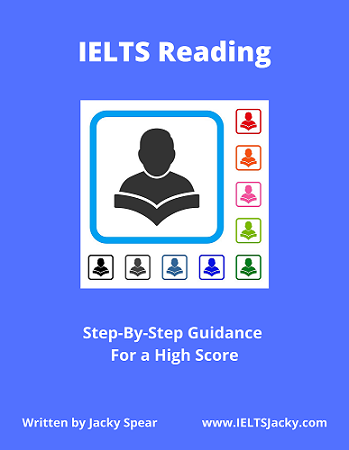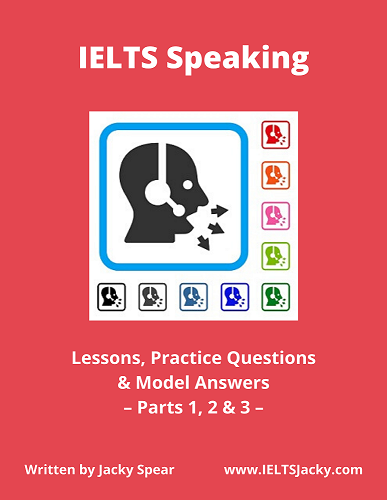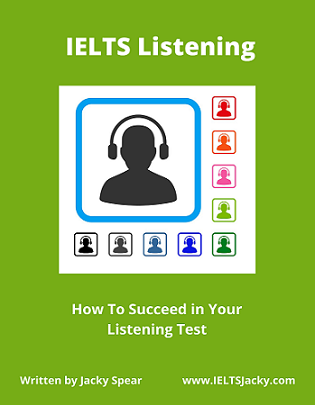IELTS Reading
Sentence Completion Questions
Sentence completion
questions are common in the IELTS Reading test. As long as you have a good
strategy to answer them and have done lots of practice before the exam, they
shouldn’t give you too much of a problem.
I’ve created this page to help you with your preparation. Here’s what it covers:
- Explanation of this question type
- Skills needed
- Key tips
- The strategy
Explanation of this question type
- You will be given a set of four or five sentences with gaps in them.
- You are required to fill the
gaps with appropriate words to complete the meaning of the sentence.
The instructions will tell
you how many words you are allowed to use to fill the gap. Read them very
carefully. They will most likely tell you to use ONE WORD ONLY or NO MORE THAN
TWO WORDS.
If you use the wrong number of words, your answer will be marked incorrect even if the information you give is correct.
The instructions will also state whether you have to use words taken from the reading text or if you can use different ones, that is, synonyms.
Here’s an example of instructions taken from a past test paper. In this case, you can only use ONE WORD for your answer and it must come from the text.
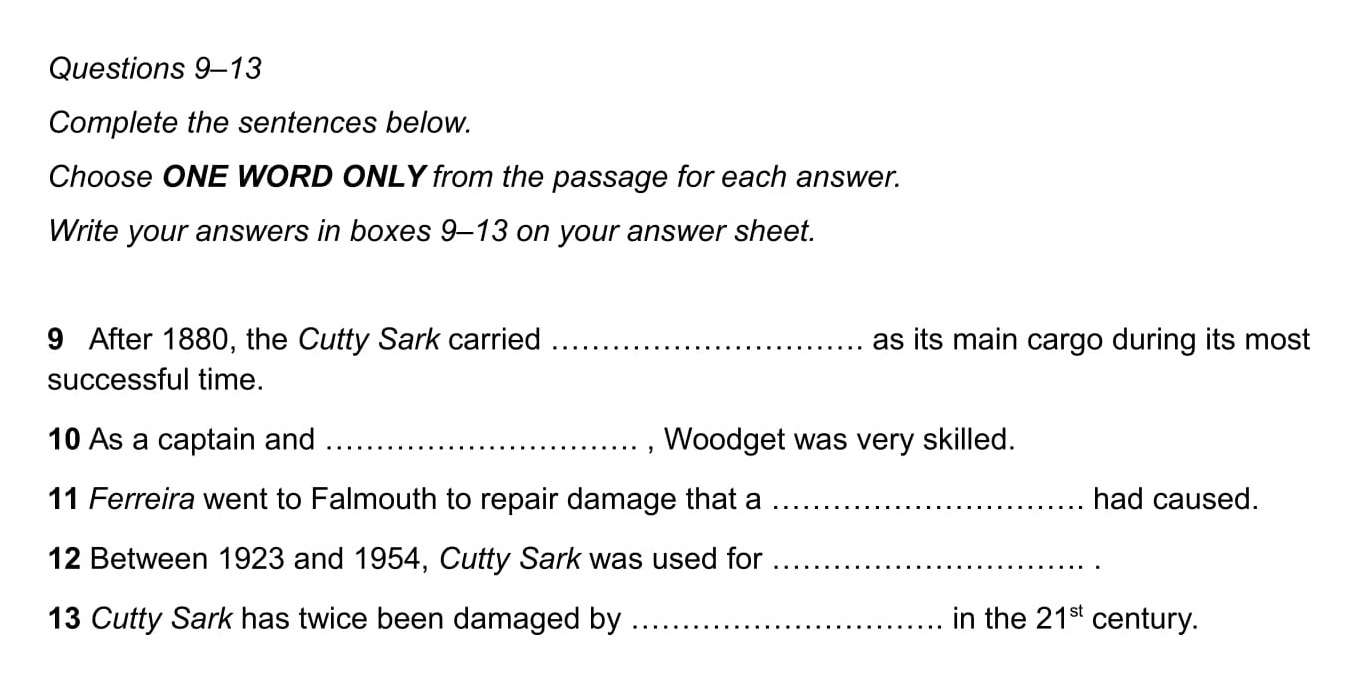
Source: Cambridge English Past Test Paper
Skills needed
This type of question tests your ability to:
- Identify synonyms
- Understand paraphrasing
- Scan for specific information
- Read in detail for meaning
You need a good knowledge and understanding of synonyms and paraphrasing for all IELTS Reading questions but they are particularly important in sentence completion questions. Here’s a quick reminder of what each of them is.
Synonyms are words that mean exactly or nearly the same as a given word. For example, for the word ‘true’ you could also use, ‘genuine’, ‘accurate’, ‘factual’ or ‘correct’.
Paraphrasing is saying the same thing in different ways, using different words and/or a different sentence structure. For example,
a) The new restaurant was small and cosy and the food excellent.
b) The cuisine served in the new eatery was superb and the atmosphere intimate.
You’ll notice that the paraphrased sentence (b) contains a number of synonyms as well as being structured in a different way to the original sentence (a).
These synonyms have been use:
restaurant à eatery
small and cosy à intimate
food à cuisine
excellent à superb
Key tips
1) Read the instructions carefully to find out:
a) how many words you should write for the answer.
b) if you have to use the exact words from the text or can use synonyms.
2) Read the sentences before you read the text. It’s a waste of time reading the passage first as you don’t know what information you’re looking for until you’ve read and understood the sentences.
3) The answers appear in the same order in the text as the order of the list of incomplete sentences.
4) The completed sentences must be grammatically correct. If they aren’t, then you have the wrong answer.
5) When first studying the sentences, try to work out what type of word is missing, e.g. a noun, a verb, an adjective or an adverb. This will help you to find it more quickly.
6) Scan to find the location of the answer, then read in detail to find the answer itself.
7) Always be thinking about synonyms and paraphrasing. Look for matching meaning rather than exact word matches when comparing the information in the sentences and the text.
The Strategy
I’ll show you how to apply this strategy in the example
below but first, you need to understand it.
# 1 Carefully read the instructions.
# 2 Read the sentences with the gaps in. Try to understand what they mean.
# 3 Try to predict the type of word that's missing, e.g. a noun, a verb, an adjective or an adverb. Occasionally you may even be able to guess the missing word.
# 4 Underline key words to scan for in the text. Include names, numbers, dates and places if there are any as these will be easy to spot. Think about possible synonyms as you do this.
# 5 Scan the text for the keywords in the first sentence.
It’s important that you start with this one even if you think some of the other sentences will be easier to complete. Remember, the answers will come in order in the text so it will be much easier and quicker if you search for them in order.
# 6 Finding the key words will show you where the answer is located. You then need to read that part of the text in detail to find the actual answer.
The text will probably paraphrase the incomplete sentence so you’ll need to interpret what it means to find the correct match of information. Then identify the word or words you need for the answer.
# 7 When you’ve found the answer, fill in the answer sheet. Check that the sentence is grammatically correct and that your spelling is correct.
# 8 Repeat this process with the next sentence and so on until you have completed them all.
# 9 If there’s a sentence you really struggling with, take a guess at the missing word and move on. If you waste too much time trying to get this one mark, you’ll run out of time and miss out on easier marks later on.
Example with answers
This example comes from the official IELTS website, www.ielts.org. Before checking the answers, see if you can fill in the gaps in the sentences following the steps in the strategy.
This passage is just a part of the whole text used in the real exam paper. In your exam, you will be working with a longer text.
When you’ve completed the task, read my notes below which contain the answers.
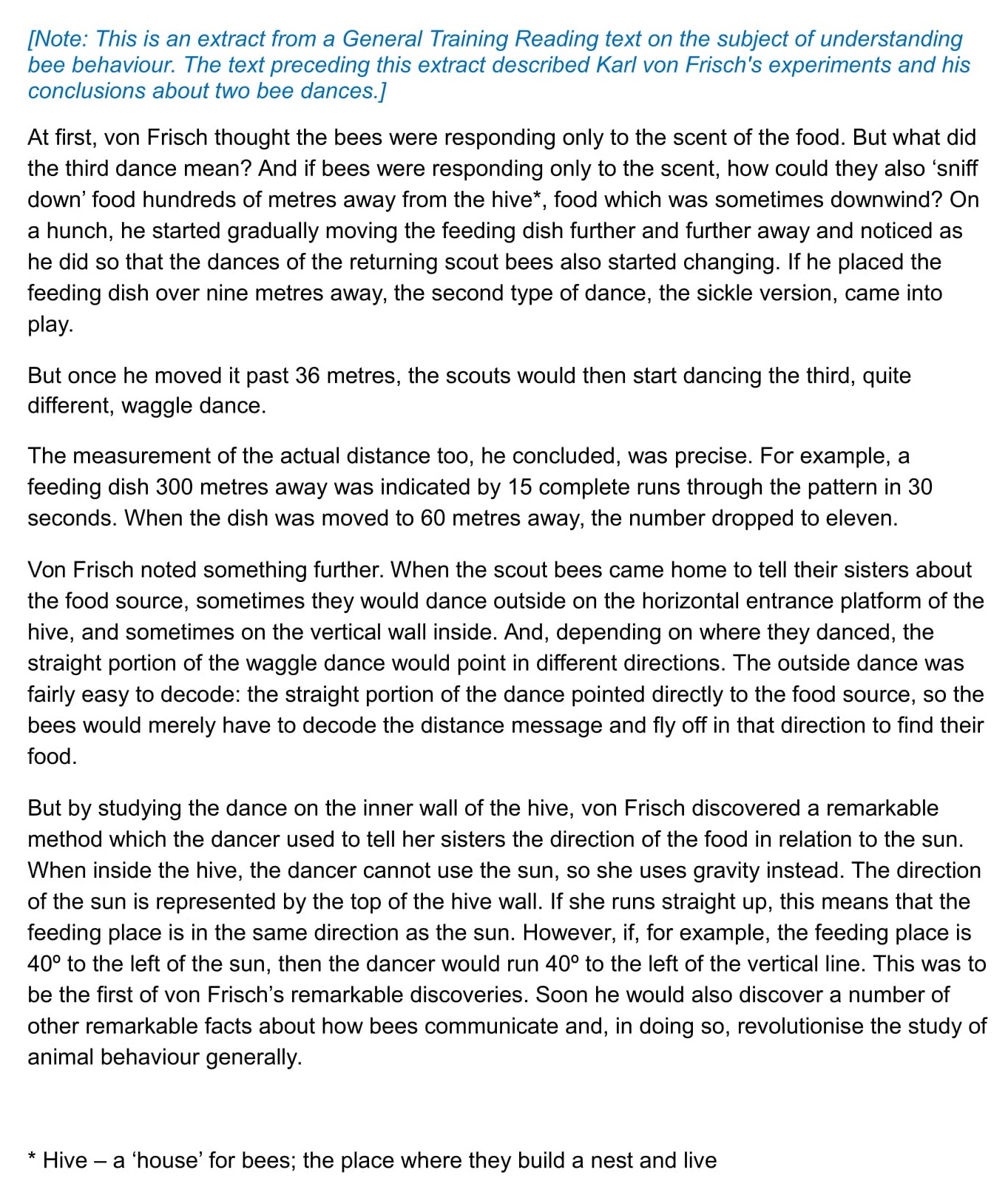
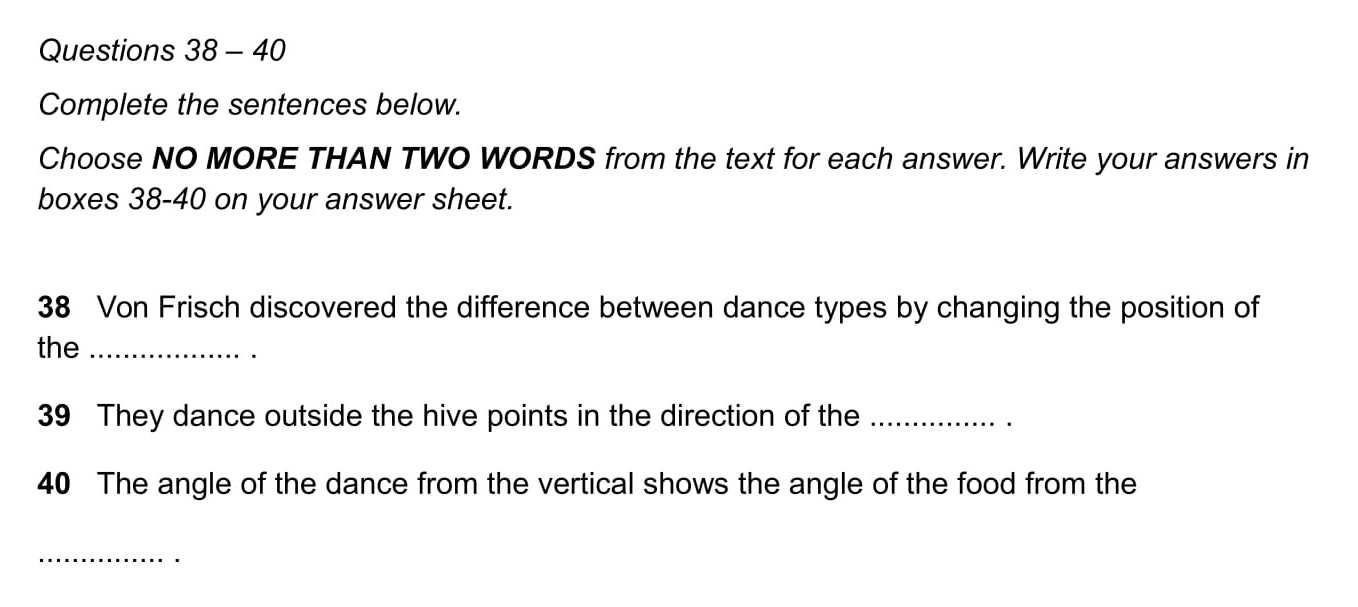
Source: Official IELTS website ielts.org - Sentence Completion Sample Test
Notes on how I answered the questions
1) I read the instructions and note that I must write NO MORE THAN TWO WORDS for each answer and that I must choose words from the text.
2) I read the three sentences 38–40 carefully and try to understand what they mean.
I predict that all the missing words will be nouns because they are preceded by an article word – ‘the’.
I also highlight key words and think about possible synonyms for them.
38 Von Frisch discovered
the difference between
dance types by changing the position of
the .................. .
39 The dance outside the hive points in the direction of the ............... .
40 The angle of the dance from the vertical shows the angle of the food from the ............... .
3) I now scan the text for the key words I’ve chosen in
sentence 38. I start with ‘Von Frisch’ as it will be easy
to find. Indeed, I spot it right at the beginning of the text.
I now scan for my other key words which will tell me if the answer is here or if I need to search further on.
At first, von Frisch thought
the bees were responding only to the scent of the food. But what did the third dance mean? And if bees were responding only to the scent,
how could they also ‘sniff down’ food hundreds of metres away from the hive*,
food which was sometimes downwind? On a hunch, he started gradually moving the feeding dish further
and further away and noticed as he did so that the dances
of the returning scout bees also started changing. If he placed the feeding
dish over nine metres away, the second type of dance, the sickle version, came into play.
I
also find them in this paragraph so I know this is the right location. I go
back and re-read sentence 38 to find
more clues as to the answer I’m looking for.
It says that von Frisch is ‘changing the position’ of something so I scan the paragraph again looking for the word ‘changing’ or one that means a similar thing.
There is use of both synonyms and paraphrasing here and the only word I can see that clearly indicates that von Frisch has done something different is ‘moving’. What did he move? The ‘feeding dish’.
I go back to sentence 38 to check if this word is a good fit. It is. It makes sense, gives the sentence the same meaning as the text, is grammatically correct and is the right number of words. I have the first answer – feeding dish.
It’s easy to panic if the answer is hidden in paraphrasing. If you stay calm and work with the clues you do have, you’ll be able to identify the answer.
Answer 38: feeding dish
4) I now go to sentence 39 and scan for the key words ‘dance’, ‘hive’ and ‘direction’.
(Note that the word ‘hive’ has an asterisk (*) beside it and an explanation of the meaning of it underneath the text. You will sometime be given the meaning of an unusual key word that’s vital to the understanding of the text.)
39 The dance outside the hive points in the direction of the ............... .
Since the answers come in order in the text, I ignore the text above the previous answer and start scanning from the next paragraph.
I find a section of text where ‘dance’, ‘hive’ and ‘direction’ or a close match all occur close together several times so guess this is the best place to look for the answer.
But by studying the dance on the inner wall of the hive, von Frisch discovered a remarkable method which the dancer used to tell her sisters the direction of the food in relation to the sun. When inside the hive, the dancer cannot use the sun, so she uses gravity instead. The direction of the sun is represented by the top of the hive wall. If she runs straight up, this means that the
feeding place is in the same direction as the sun.
I read sentence 39
again to make sure that I fully understand it and know what I need to find out. I need to find out which direction the dance is pointing in.
I return to the section of text and read in detail. I spot the phrase ‘the direction of the food in relation to the sun’. This is too many words to be my answer so I identify the key word which is ‘food’.
I check back to see if it’s a good fit for the gap in the sentence. It is. It makes sense, gives the sentence the same meaning as the text, is grammatically correct and is the right number of words. I have the second answer – food.
Answer 39: food (source)
The word in brackets is optional - it is correct, but not necessary.
5) I now go to the final sentence and scan for the key words I’ve selected – ‘food’, ‘vertical’ and ‘angle’.
40 The angle
of the dance from the vertical
shows the angle of the food from the ............... .
I find ‘food’ and related word ‘feeding’, and ‘vertical’ in a section of the last paragraph. I can’t find ‘angle’ but I do spot ‘40º’ which I know is a specific angle. This must be the right location.
But by studying the dance on the inner wall of the hive, von Frisch discovered a remarkable method which the dancer used to tell her sisters the direction of the food in relation to the sun. When inside the hive, the dancer cannot use the sun, so she uses gravity instead. The direction of the sun is represented by the top of the hive wall. If she runs straight up, this means that the feeding place is in the same direction as the sun. However, if, for example, the feeding place is 40º to the left of the sun, then the dancer would run 40º to the left of the vertical line.
I read sentence 40
again. It’s not very easy to understand. If you don’t know the meaning of the
word ‘vertical’ it will be even harder. However, you don’t always need to
understand all the key words. Use them to find the location of the answer in
the text, then work with what you do understand to find the missing word.
I don’t waste time trying to fully understand the sentence but focus on the few words immediately before the gap. These tell me what the missing word relates to.
the angle
of the food from the ............... .
Basically, the phrase is about ‘direction’ again, the
direction of the food from something. I go back to the text and read in detail
for a phrase that relates to this. I find three.
- the direction of the food in relation to the sun
- the feeding place is in the same direction as the sun
- the feeding place is 40º to the left of the sun
The main idea in all of them is the relationship between the food and the direction of the sun, so the answer must be sun.
I make sure that it's a good fit for the sentence and now all the answers are complete.
Answer 40: sun
Answers
38 feeding dish
39 food
40 sun
Want to watch the video of this page? Click here.
I hope you’ve found these extra notes helpful. Use this strategy and all the tips to practice answering sentence completion questions from past IELTS Reading test papers. This will quickly improve both your skills and your level of confidence.
Like this page?
Lessons On All Question Types
For more sample questions with step-by-step instructions, see the IELTS Reading menu page.
More Reading Test Pages
IELTS Reading Test – Understand the format, question types & marking system & know what skills are assessed. Also learn success strategies, key reading skills & discover top tips.
IELTS Reading Skills – Master the skills of skimming, scanning & detailed reading. Understand the importance of topic sentences & how to use context for meaning & unfamiliar words.
Top 7 IELTS Reading Tips – Each tip will take you a step closer to the high score you want. They are the key to top marks in your test.
9 More Tips For IELTS Reading – Learn valuable practice techniques & discover a secret that may gain you extra marks.
IELTS Reading Practice – Discover the top 5 things you must do to prepare for your reading test.
How to Complete the IELTS Reading Test in 60 Minutes – Top 6 Recommendations.
IELTS Academic Reading – Why you should take IELTS Academic Reading, test format, text types &
sample tests.
IELTS General Reading – Why you should take IELTS General Reading, test format, text types & sample tests.
Reading Practice Samples – Short activities to improve your reading skills & help you learn topic vocabulary.



